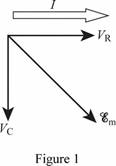
(a)
The frequency of the RC circuit.
(a)
Answer to Problem 46P
The frequency of the series RC circuit is
Explanation of Solution
The resistor with resistance of
Write the expression for voltage drop across the resistor
Here,
Write the expression for voltage drop across the capacitor
Here,
Write the expression for capacitive reactance
Here,
Substitute (III) in (II)
Equate (I) and (IV) since resistor and capacitor has the same rms voltage
Rearrange for
Substitute
Thus, the frequency of the series RC circuit is
(b)
The rms voltage of the resistor and capacitor as fraction of the source voltage.
(b)
Answer to Problem 46P
The rms voltage of the resistor and capacitor as fraction of the source voltage is
Explanation of Solution
The phasor diagram for the series RC circuit is given below:

Write the expression for source voltage using the phasor diagram
Here,
Substitute
Rearrange
Take square root on both sides
Since both resistor and capacitor has the same rms voltage.
Thus, the rms voltage of resistor and capacitor is not half the rms voltage of the source.
(c)
The phase angle between the source voltage and the current.
(c)
Answer to Problem 46P
The phase angle between the voltage and current is
Explanation of Solution
Write the expression for phase angle
Here,
Rearrange
Write the expression for impedance
Substitute
Multiply both numerator and denominator by
Substitute (I) and (II) in (XIV).
Substitute (VII) in (XV).
Substitute (IX) in (XV).
Thus, the phase angle between the voltage and current is
(d)
The impedance of the series RC circuit.
(d)
Answer to Problem 46P
The impedance is
Explanation of Solution
Rearrange (XI)
Substitute
Thus, the impedance is
Want to see more full solutions like this?
Chapter 21 Solutions
Physics
- A 75.0-kg person drops from rest a distance of 1.20 m to a platform of negligible mass supported by an ideal stiff spring of negligible mass. The platform drops 6.00 cm before the person comes to rest. What is the spring constant of the spring? Please do on paper and show all equations and work done to get to the final answer. Along with any helpful diagrams if needed. These are a part of my review questions in the book but i keep getting different answers from what the book says, it is not a graded assignment***arrow_forwardProblem Ten. A uniform rod is suspended in mechanical equilibrium by two strings. If T₁ = 500 N, what is the weight of the rod (in N)? 18.) (A) 120 N (D) 600 N (B) 900 N (C) 500 N (E) 220 N T T Mg STAY Carrow_forwardIn the figure, two boxes, each of mass 35 kg, are at rest and connected as shown. The coefficient of kinetic friction between the inclined surface and the box is 0.38. Find the speed of the boxes just after they have moved 5.5 m. Please do on paper and show all formulas and work done to get final answer This is a review problem , I just keep getting the wrong thing from what the textbook says , so i would like to see the work donearrow_forward
- A 64.0-kg skier starting from rest travels 200.0 m down a hill that has a 30.0° slope and a uniform surface. When the skier reaches the bottom of the hill, her speed is 30.0 m/s. How much work is done by friction as the skier comes down the hill? Please do on paper and show all the equations and work done to get to the final answer.arrow_forwardA 550-kg car moving at 18.5 m/s hits from behind a 560-kg car moving at 11.8 m/s in the same direction. If the new speed of the heavier car is 16.0 m/s, what is the speed of the lighter car after the collision, assuming that any unbalanced forces on the system are negligibly small? Please do on paper and show all equations and work done to get to the final answer. Along with any helpful diagrams if needed. These are a part of my review questions in the book but i keep getting different answers from what the book says, it is not a graded assignment***arrow_forwardA 150kg piano rolls down a 30° incline. A man tries to keep it from accelerating, and manages to keep its acceleration to 1.4 m/s^2 . If the piano rolls 8 m, what is the net work, in joules, done on it by all the forces acting on it? Please do it on paper and show all formulas and work used to get the answerarrow_forward
- The rectangular loop of wire shown in the figure (Figure 1) has a mass of 0.18 g per centimeter of length and is pivoted about side ab on a frictionless axis. The current in the wire is 8.5 A in the direction shown. Find the magnitude of the magnetic field parallel to the y-axis that will cause the loop to swing up until its plane makes an angle of 30.0 ∘ with the yz-plane. The answer is .028 T, I just need help understanding how to do it. Please show all steps.arrow_forwardA ray of light from an object you want to look at strikes a mirror so that the light ray makes a 32 degree angle relative to the normal line (a line perpendicular to the surface of the mirror at the point where the ray strikes the mirror). If you want to see the object in the mirror, what angle does your line of sight need to make relative to the normal line? Give your answer as the number of degrees.arrow_forwardSuppose you have a converging lens with a focal length of 65 cm. You hold this lens 120 cm away from a candle. How far behind the lens should you place a notecard if you want to form a clear image of the candle, on the card? Give your answer as the number of centimeters.arrow_forward
- Suppose you have a diverging lens with a focal length of - 25 cm. You look through this lens at a sleeping squirrel, and notice that it forms a virtual image of the squirrel with di = - 18 cm. How far away from the lens is the squirrel? Give your answer as the number of centimeters (a positive number).arrow_forwardDiamond has an index of refraction of about 2.4. Suppose you cut a diamond so it has a flat surface, and shine a laser pointer beam so that it makes a 27 degree angle with respect to the normal line to that surface. What angle will the laser beam make with respect to the normal after it passes through the air-diamond boundary and is inside the diamond? Give your answer as the number of degrees.arrow_forwardFind current of each line of D,E, and F. Where V1 is 9V, V2 is 7V, R1 is 989 , R2 is 2160, R3 is 4630 , R4 is 5530, R5 is 6720, and E is 16V. Please explain all steps. Thank youarrow_forward
 College PhysicsPhysicsISBN:9781305952300Author:Raymond A. Serway, Chris VuillePublisher:Cengage Learning
College PhysicsPhysicsISBN:9781305952300Author:Raymond A. Serway, Chris VuillePublisher:Cengage Learning University Physics (14th Edition)PhysicsISBN:9780133969290Author:Hugh D. Young, Roger A. FreedmanPublisher:PEARSON
University Physics (14th Edition)PhysicsISBN:9780133969290Author:Hugh D. Young, Roger A. FreedmanPublisher:PEARSON Introduction To Quantum MechanicsPhysicsISBN:9781107189638Author:Griffiths, David J., Schroeter, Darrell F.Publisher:Cambridge University Press
Introduction To Quantum MechanicsPhysicsISBN:9781107189638Author:Griffiths, David J., Schroeter, Darrell F.Publisher:Cambridge University Press Physics for Scientists and EngineersPhysicsISBN:9781337553278Author:Raymond A. Serway, John W. JewettPublisher:Cengage Learning
Physics for Scientists and EngineersPhysicsISBN:9781337553278Author:Raymond A. Serway, John W. JewettPublisher:Cengage Learning Lecture- Tutorials for Introductory AstronomyPhysicsISBN:9780321820464Author:Edward E. Prather, Tim P. Slater, Jeff P. Adams, Gina BrissendenPublisher:Addison-Wesley
Lecture- Tutorials for Introductory AstronomyPhysicsISBN:9780321820464Author:Edward E. Prather, Tim P. Slater, Jeff P. Adams, Gina BrissendenPublisher:Addison-Wesley College Physics: A Strategic Approach (4th Editio...PhysicsISBN:9780134609034Author:Randall D. Knight (Professor Emeritus), Brian Jones, Stuart FieldPublisher:PEARSON
College Physics: A Strategic Approach (4th Editio...PhysicsISBN:9780134609034Author:Randall D. Knight (Professor Emeritus), Brian Jones, Stuart FieldPublisher:PEARSON





